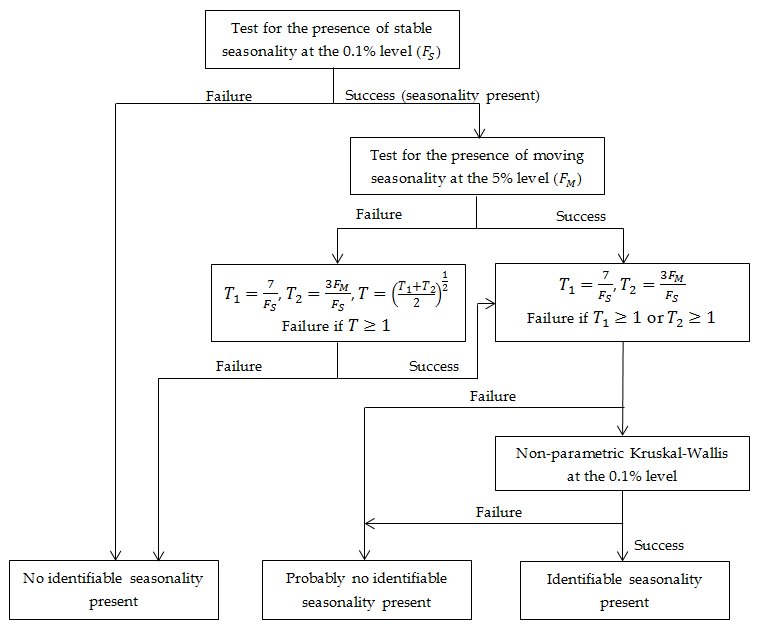Tests
In this chapter
This chapter describes all the tests available in JDemetra+, via Graphical User Interface and R packages. Here the underlying theoretical principles of each test are provided.
to be added: which test are done when Seats decomposition vs X-13-ARIMA.
Tests on residuals
| Test | Purpose | GUI | R package |
|---|---|---|---|
| Ljung-Box | autocorrelation | ✔️ | rjd3tookit |
| Box-Pierce | autocorrelation | ✔️ | |
| Doornik-Hansen | normality | ✔️ | rjd3tookit |
Ljung-Box
The Ljung-Box Q-statistics are given by:
where
If the residuals are random (which is the case for residuals from a well specified model), they will be distributed as
Box-Pierce
The Box-Pierce Q-statistics are given by:
where:
If the residuals are random (which is the case for residuals from a well specified model), they will be distributed as
Dornik-Hansen
The Doornik-Hansen test for multivariate normality (DOORNIK, J.A., and HANSEN, H. (2008)) is based on the skewness and kurtosis of multivariate data that is transformed to ensure independence.
The skewness and kurtosis are defined, respectively, as:
where:
The Doornik-Hansen test statistic derives from SHENTON, L.R., and BOWMAN, K.O. (1977) and uses transformed versions of skewness and kurtosis.
The transformation for the skewness
The kurtosis
Finally, the Doornik-Hansen test statistic is defined as the sum of squared transformations of the skewness and kurtosis. Approximately, the test statistic follows a
Seasonality tests
table with all tests by purpose and accessibility
| Test | Purpose | GUI | R package |
|---|---|---|---|
| QS test | Autocorrelation at seasonal lags | ✔️ | |
| F-test with seasonal dummies | Stable seasonality | ✔️ | rjd3toolkit |
| Canova-Hansen | Seasonal frequencies | ✖ | rjd3toolkit |
| Identification of spectral peaks | Seasonal frequencies | ✔️ | |
| Friedman test | Stable seasonality | ✔️ | rjd3toolkit |
| Two-way variance analysis | Moving seasonality | ✔️ |
QS Test on autocorrelation at seasonal lags
The QS test is a variant of the Ljung-Box test computed on seasonal lags, where we only consider positive auto-correlations
More exactly,
where
Under H0, which states that the data are independently distributed, the statistics follows a
Maravall (2012) proposes approximate the correct distribution (p-values) of the QS statistic using simulation techniques. Using 1000K replications of sample size 240, the correct critical values would be 3.83 and 7.09 with confidence levels of
Statistically significant positive autocorrelation at lag 12
Non-negative sample autocorrelation at lag 12 and statistically significant positive autocorrelation at lag 24
F-test on seasonal dummies
The F-test on seasonal dummies checks for the presence of deterministic seasonality. The model used here uses seasonal dummies (mean effect and 11 seasonal dummies for monthly data, mean effect and 3 for quarterly data) to describe the (possibly transformed) time series behaviour. The test statistic checks if the seasonal dummies are jointly statistically not significant. When this hypothesis is rejected, it is assumed that the deterministic seasonality is present and the test results are displayed in green.
This test refers to Model-Based $^{2}$ and F-tests for Fixed Seasonal Effects proposed by LYTRAS, D.P., FELDPAUSCH, R.M., and BELL, W.R. (2007) that is based on the estimates of the regression dummy variables and the corresponding t-statistics of the Reg-ARIMA model, in which the ARIMA part of the model has a form (0,1,1)(0,0,0). The consequences of a misspecification of a model are discussed in LYTRAS, D.P., FELDPAUSCH, R.M., and BELL, W.R. (2007).
For a monthly time series the Reg-ARIMA model structure is as follows:
where:
In the case of a quarterly series the estimated model has this form:
where:
One can use the individual t-statistics to assess whether seasonality for a given month is significant, or a chi-squared test statistic if the null hypothesis is that the parameters are collectively all zero. The chi-squared test statistic is
where
This statistic follows a
Friedman test for stable seasonality
The Friedman test is a non-parametric method for testing that samples are drawn from the same population or from populations with equal medians. The significance of the month (or quarter) effect is tested. The Friedman test requires no distributional assumptions. It uses the rankings of the observations. If the null hypothesis of no stable seasonality is rejected at the 0.10% significance level then the series is considered to be seasonal and the test’s outcome is displayed in green.
The test statistic is constructed as follows. Consider first the matrix of data
The data matrix needs to be replaced by a new matrix
The test statistic is given by
where
Under the hypothesis of no seasonality, all months can be equally treated. For the sake of completeness:-
For large
Moving seasonality test
The evolutive seasonality test is based on a two-way analysis of variance model. The model uses the values from complete years only. Depending on the decomposition type for the Seasonal/Irregular component it uses Equation 1 (in the case of a multiplicative model) or Equation 2 (in the case of an additive model):
where:
The test is based on the following decomposition:
where:
The null hypothesis
which follows an
Combined seasonality test
This test combines the Kruskal-Wallis test along with test for the presence of seasonality assuming stability (

Identification of spectral peaks
Tests related to identification of spectral peaks in a periodogram, autoregressive spectrum or Tuckey spectrum are detailed here in the chapter dedicated to spectral analysis.